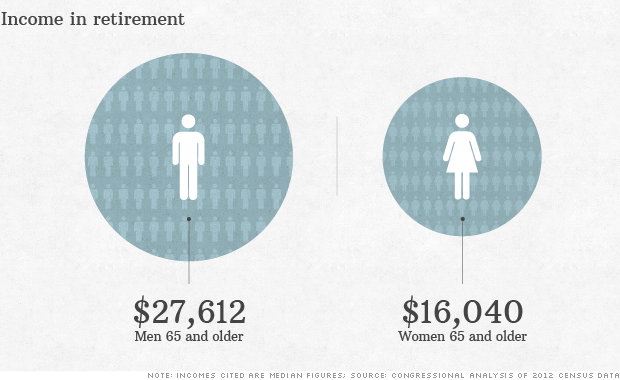
On average, senior women live on far less annual income than men.
NEW YORK (CNNMoney)
In fact, women are almost twice as likely as men to live below the poverty line during retirement, with single and minority women struggling the most (see chart).
Life below the poverty line
| All 65 and older | 6.6% | 11% |
| Married | 4.7% | 4.9% |
| Widowed | 10.1% | 14.5% |
| Divorced | 12.2% | 17.1% |
| Separated | 10.8% | 35.4% |
| Never married | 15.7% | 23.2% |
| White | 4.6% | 8.6% |
| Black | 13.2% | 21.3% |
| Asian | 11.6% | 11.9% |
| Hispanic | 19.1% | 21.8% |
Source: GAO analysis of Census data for 2012
On average, women 65 years and older rely on a median income of around $16,000 a year -- roughly $11,000 less than men of the same age, according to a Congressional analysis of Census data. And many elderly women rely exclusively on Social Security benefits.
The problem: Women earn -- and save -- less over their lifetimes than men, leaving them with a smaller nest egg. And because they tend to live longer, that savings has to last longer, too.
"You combine lower resources with longer life expectancies and very quickly you can identify that there is more risk here," said Dave Littell, retirement income program director at The American College, an institution which educates financial planners and advisers.
Calculator: Will you have enough to retire?
Here are some of the leading factors driving the retirement income gap between the sexes and some solutions to help fix it:
Lower overall earnings: On average, full-time working women earn just 77 cents for every dollar a man earns, according to the federal government.
The lower earnings hit both the Social Security benefits women accrue over the years and their ability to save for retirement.
Related: Retired women: 'How I get by'
Also, female workers make up about two-thirds of all part-time employees. And the majority of those jobs don't come with employer-sponsored retirement benefits.
That makes it harder to save for retirement at all, let alone to accumulate a nest egg large enough to last decades.
Proposals to help workers who do not receive workplace retirement benefits, such as Obama's new myRA plan, are a start but unlikely to make any major improvements.
Gaps in employment: On average, women work 12 years less than men do over the course of their careers, according to the AARP Public Policy Institute.
A major reason: Women are more likely to take time off work to raise kids or to care for a sick spouse or aging parents.
Barbara Bennett, 65, left a high-paying executive position a decade ago to help care for her sick husband, who needed full-time care. But since her husband passed away six years ago, she has struggled to find work.
Related: Can the government get us to save more for retirement?
"What do I do on the top of my resume: Full-time caregiver to deceased spouse?," she said.
And since Social Security benefits are based on a worker's top 35 years of earnings, time out of the workforce can result in a smaller benefit throughout retirement.
One possible fix: to provide "caregiver credits" towards Social Security for workers who are providing unpaid care, said Barbara Butrica, a senior fellow at the Urban Institute. But while the proposal has been made in past Congressional sessions, it hasn't gained much traction.
An outdated Social Security system: The Social Security program was designed to support married couples where one spouse was the breadwinner. Yet today, a growing number of women are getting married later in life, remaining single or have gotten divorced, and many more women are earning their own benefits in the workforce.
As a result, far fewer women receive spousal benefits based on their husband's work history, according to a Government Accountability Office report. That's good news for women who have earned a lot over the years, but bad news for women whose lifetime earnings are low.
Related: Daughters earn more than their moms did, but not their dads
On average, women still receive Social Security benefits that are thousands of dollars less annually than benefits that men receive, according to the Social Security Administration.
Higher costs: Whether they entered retirement single or end up outliving their spouse, many elderly women end up facing the higher living costs associated with living on their own.
In fact, only 45% of women 65 years and older were married in 2013, compared to 71% of men, according to Census data.
Since women live longer, they also tend face higher medical costs in retirement, according to the AARP Public Policy Institute.
"Even if we move more towards 100% pay equity, there are still going to be (all of these) issues," Butrica said. ![]()
First Published: May 13, 2014: 7:02 PM ET
Anda sedang membaca artikel tentang
Why many retired women live in poverty
Dengan url
http://brokolsayuransehat.blogspot.com/2014/05/why-many-retired-women-live-in-poverty.html
Anda boleh menyebar luaskannya atau mengcopy paste-nya
Why many retired women live in poverty
namun jangan lupa untuk meletakkan link
Why many retired women live in poverty
sebagai sumbernya
0 komentar:
Posting Komentar